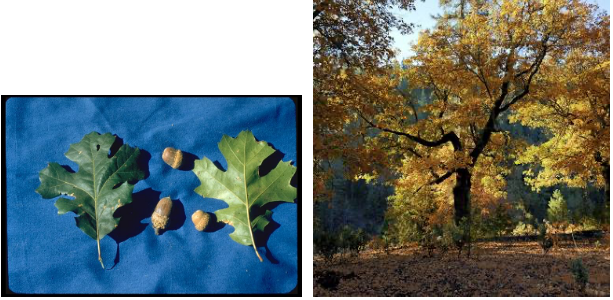
Black oaks (Quercus kelloggii) are one of many oaks that live in the foothills but it is the favored oak of the Nisenan and other tribes because its acorns are big and the sweetest of all the oaks. Typically, they range from 30-80 ft high and 1- 4.5 ft in diameter but can grow much larger- up to 120 ft high and over 5ft in diameter. The black oak has dark bark and has lobed deciduous leaves with spiny tips on each lobe. The leaves turn a beautiful gold in the fall. Deer, squirrels, jays, woodpeckers and other mammals depend on the acorns and many other species use different parts of the tree for food and or shelter. They are important for several species of butterflies including the California Sister and Golden Hairstreak. There are several large black oaks along this trail. Can you spot them? Oak woodlands are a rich and valuable habitat wherever they occur.
Encinas Negro (Quercus kelloggii) son uno de los muchos robles que viven en las colinas, pero es el roble favorito de los Nisenan y otras tribus porque sus bellotas son grandes y las más dulces de todos los robles. La encina tiene la corteza oscura y tiene hojas caducas lobuladas con puntas espinosas en cada lóbulo. Las hojas se vuelven de un hermoso color dorado en otoño. Venados, ardillas, arrendajos, pájaros carpinteros y otros mamíferos dependen de las bellotas y muchas otras especies usan diferentes partes del árbol como alimento o refugio. Hay varias encinas grandes a lo largo de este sendero. ¿Puedes detectarlas? Los bosques de robles son un hábitat rico y valioso dondequiera que se encuentren.
